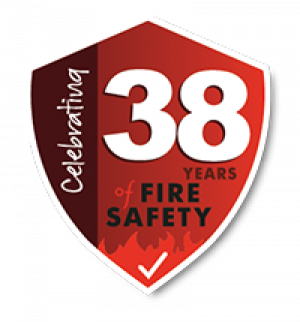How Do Fire Extinguishers Work?
8th Dec 2021

Fire extinguishers are essential equipment that can help protect you and reduce any further risk of harm or damage during a fire. In most business premises they are required by law. There are different types of extinguishers that are used for various types of fire. They each work in different ways.
Water extinguishers
Water extinguishers only contain water and a pressurised propellant gas such as nitrogen. The water removes heat from the fuel, to the point where combustion can no longer be supported.
On a water extinguisher like the others listed below, there’s pin on the handle that stops the extinguisher from being set off by mistake. If it’s missing, or the tamper seal is broken, it’s a sign that the extinguisher needs to be checked by an extinguisher technician. Once the pin is pulled from the extinguisher and the handle is pressed, the pressurised gas pushes the water downward into the siphon tube that runs from the top to the bottom of the extinguisher, and then into the discharge hose.
Water extinguishers are only effective on Class A (combustible materials) fires, and they are not suitable on fires involving flammable liquids or electrical risks.
Carbon dioxide extinguishers
Carbon dioxide (CO2) extinguishers contain high pressure carbon dioxide. This can suffocate the fire by displacing the oxygen from it and replacing it with the inert CO2 gas..
A carbon dioxide extinguisher has a much larger, cone shaped nozzle compared with other extinguishers. This allows the CO2 gas room to expand and spread once it’s released.
Carbon dioxide shouldn’t be used while the operator is in a confined space - because it displaces oxygen there is a risk of asphyxiation. It’s also important to ensure that the fire does not reignite after using a carbon dioxide extinguisher as they don’t remove the heat from the fuel to any great extent.
These extinguishers are normally sited in areas where there is electrical equipment, as the gas is a non conductor. They are also effective on smaller flammable liquid fires.
Foam extinguishers
Foam extinguishers contain a foaming agent that both smothers and slightly cools the burning substance. Like the water extinguisher they also have a compressed gas acting as the propellant.
There are various types of foam extinguishers – some are general purpose, others are more specialised, such as those designed for use on cooking oil fires. They are generally designed to be safe on electrical risks.
Dry powder extinguishers
Dry powder extinguishers contain a fire suppressing chemical powder, again with a compressed gas propellant. The powder interferes with the chain of combustion and may also have a smothering effect.
They are multi purpose and have high fire ratings, but should not be used in confined spaces. The powder can also be corrosive so should not be used near delicate electronic equipment.
You can view our range of fire extinguishers here or contact us today for more information.
How To Tell If Your Fire Extinguisher Has Expired - Read More!






